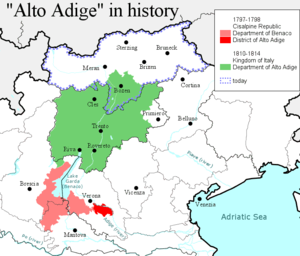
History of Trentino
History – The Modern Age
During the late 19th Century Trento and Trieste, Italian cities still belonging to the Austrians, became icons of the national unification movement. The nationalist cause led Italy into World War I. The region was greatly affected during the war, and some of its fiercest battles were fought on the surrounding mountains. After the war, Trento and the surrounding region, whose inhabitants are in vast majority Italian-speaking, was given to Italy, where it belongs to date.
Eight centuries of Prince-Bishop rulers, relative independence from the rest of Europe and a strong sense of communal fate left a distinctive mark on the city’s culture, which is dominated by a progressive Social-Catholic political orientation.
From Enchanting Italy
Purchase Farmers and Nobles by clicking the photo or son Amazon
More Ancient history
During the Stone age the valleys of what is now Trentino were already inhabited by humans, the main settlements being in the valley of the Adige River, thanks to its milder climate. Research suggests that the first settlers (probably hunters) came from the Padana Plain and the Venetian Prealps, after the first glaciers began melting at the end of the Pleistoceneglaciations.
Findings (in particular, burials) from the Mesolithic period have been found in several parts of the province. These include the comuniof Zambana and Mezzocorona. A large area of a hunting-based settlement from the Neolithicperiod has been found near the lakes of Colbricòn, not far from the Rolle Pass.
Around 500 BC, the Raetians appeared in the Trentine area, coming from the Central and Eastern Alpsarea. They settled in several valleys and brought new skills on top of the traditional hunting: agriculture (grapes, vegetables, cereals), breeding (ovines, goats, bovines and horses). During the Roman Age, part of the current Trentino-Alto Adige/Südtirol region made up the province of Raetia.
This region was totally conquered by the Romans in the 1st century BC. The definitive defeat of the Rhaetians, near Bolzano, occurred during the military campaigns in the Alps of Drusus and Tiberius(16-17 BC). Trento became a Roman municipium n the 40s BC. During the reign of Emperor Claudius(41-54 AD) Trentino was integrated in the Imperial roadnet with the construction of the Via Claudia Augusta Padana (from Ostiglia to the Resia Pass) and the Via Augusta Altinate (from Treviso to Trento, passing through the Valsugana). Claudius also issued an Edict, contained in the Tabula clesiana, which extended Roman citizenship to the residents of this region. By the fourth century the area was fully latinisated.
Bishopric of Trent
During the Late Antiquity, in the 5th century AD, Trentino was invaded several times, from North and East: first by the Ostrogoths, then by the Bavarians and Byzantines and finally by the Lombards. With the latter’s domination an idea of territorial identity of the province began to shape (Tridentinum territorium). In the same century the region became largely Christianized. In 774 Trentino was conquered by the Franks and became part of the Kingdom of Italy, a sometimes vague entity included in what was to become the Holy Roman Empire.
The first territorial unity of Trentino dates back to 1027, when emperor Conrad II officially gave the rule of the area to the Bishopric of Trent. This entity survived for some eight centuries and granted Trentino a certain autonomy, first from the Holy Roman Empire and then from the Austrian Empire.
Part of Austria
In the early 19th century some of the Trentine people participated actively in the resistance, led by the Tyrolean Andreas Hofer, against the French invasion.
Napoleon created in 1810 the Department of Alto Adigethat included most of actual Trentino and the area around Bolzano. It was part of Napoleon’s Kingdom of Italyfor some years.
After the end of the Napoleonic era (1815), the Bishopric of Trent was dissolved and Trentino became part of the County of Tyrol, in which the majority of the population was German speaking. Though relatively well administered, and despite the presence of Trentine representatives in the Dietsof Innsbruckand Vienna, in the second half of the 19th century a movement (part of the general movement called Italian irredentism) arose with the aim of annexing all the region (south of the Alps watershed) to the Kingdom of Italy: this, however, was largely put forward by intellectuals like Cesare Battist iand Fabio Filzi, and met some support by the predominantly rural population.
Given the area’s strategic importance in the event of a war between Austria-Hungary and Italy, the Austro-Hungarians strengthened their troop levels there and fortified the area in the early twentieth century. Under the authority of the Austro-Hungarian chief of staff Franz Conrad von Hötzendorf, modern, armored fortifications were built in the areas around Lavarone and Folgaria; their dual purpose was to protect against an Italian attack and to secure the area as a staging ground for an Austrian assault on Northern Italy.[2]
After Italy entered the First World War in 1915, the Trentine territory was a main fronts between Italy and Austria-Hungary, and suffered heavy destruction. After the call to arms summoned by Emperor Franz Joseph I of Austria on July 31, 1914, more than 55,000 Trentini fought for Austria, first against Russia and Serbia and, starting from 1915, also against Italians. More than 10,000 of them died, and many others were wounded or made prisoners.[3]Further, hundreds of thousands of civilians were forced to abandon their native area when they were too near to the front lines. Many of them, captured by the Italian Army, were later transferred to Southern Italy as colonists.
Union to Italy
With the Treaty of Saint-Germain(1919), Trentino was united to Italy, together with the new Province of Bolzano/Bozen (South Tyrol), as part of Venezia Tridentina. The centralization process brought on by the Fascistsreduced the autonomy that cities like Trento or Roveretohad enjoyed under the preceding Liberal governments, while many of the smaller comuniwere united, reducing their number from the 366 under the Habsburg to 127.
From Wikipedia

Researching Trentino, Campania, Liguria and Sicily
Fantastic interview on Francisco Andragnes research and family. Francisco was born in Argentina and his surname is Basque, however 75% of his ancestry is of Italian origin. Francisco’s ancestry comes from Trapani, the westernmost town in Sicily, all the way to Borgo Sacco, a town in Trentino close to the Austrian border, including also ancestors from Crocefieschi, Voltri, Finale , Laigueglia and Savona in Liguria, Meta and Piano di Sorrento in Campania, Lugo in

My Italian Ancestry by Francisco Andragnes
My Italian Ancestry By Francisco Andragnes My grandmother Elena (to the right) and her siblings in Vicenza I was born in Argentina and my surname is Basque, however 75% of my ancestry is of Italian origin. My ancestry comes from Trapani, the westernmost town in Sicily, all the way to Borgo Sacco, a town in Trentino close to the Austrian border, including also ancestors from Crocefieschi, Voltri, Finale , Laigueglia and Savona in Liguria, Meta






Pingback: History of Trentino Italy - Search My Tribe News